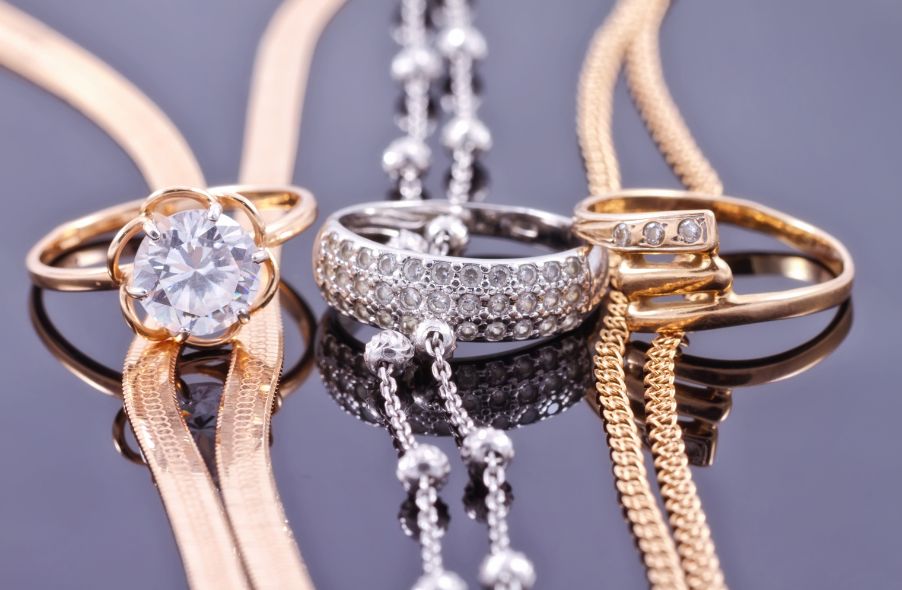
Introduction
When the word "gold" comes up, different images come to mind for different people. Some may think of gold bullion, others might imagine rare gold coins, but many immediately envision a dazzling piece of gold jewelry. In this guide, we will explore the various types of gold jewelry and delve into the basics of each option. By understanding the different colors, alloys, and purity levels of gold, you will be equipped to make an informed decision when gifting or investing in gold jewelry.
Understanding Gold
Gold is one of the most valuable natural materials found on Earth. It has a rich history dating back to ancient times and is renowned for its malleability and resistance to tarnishing. Across societies worldwide, gold is viewed as a symbol of luxury, making it the perfect choice for crafting high-end jewelry. While gold is also used in coins, bars for investing, and everyday objects like smartphones and televisions, its most common application is in jewelry.
The Different Colors of Gold
The world of gold jewelry extends far beyond traditional yellow gold. Jewelers use a variety of colors to create stunning pieces that stand out. These colors are achieved by mixing gold with other metals in what are known as alloys. Each alloy has different durability and characteristics, so it is essential to consider both the style and quality of the metal when choosing a piece of jewelry.
Yellow Gold: Classic and Timeless
Yellow gold is what most people envision when they think of gold jewelry. It is an alloy of pure gold, silver, copper, and zinc. This combination creates the iconic yellow shine associated with luxury and high value. One advantage of yellow gold is its low maintenance requirement, as it is the purest form of gold. Moreover, its higher purity level makes it a safe choice for individuals with metal allergies.
White Gold: Elegant and Durable
White gold is often mistaken for silver due to its similar appearance. However, white gold does not contain any traces of silver. Instead, it is typically a mixture of pure gold and platinum, with nickel and zinc also used in some cases. This color has gained popularity, particularly for engagement and wedding rings, because it offers a luxurious look and increased durability compared to yellow gold. White gold jewelry is less prone to scratching, making it suitable for daily wear.
Rose Gold: Trendy and Versatile
Rose gold has become increasingly popular in recent years due to its unique dusty pink hue. This alloy is a combination of gold, copper, and silver. The proportions of these metals can be adjusted to achieve different shades of rose gold. Higher concentrations of pure gold result in a shinier appearance with a paler pink color, while more copper creates a deeper pink but duller finish. Rose gold is often more affordable than yellow or white gold due to the use of inexpensive copper. It is also more durable and less prone to tarnishing.
Green Gold: A Unique Choice
Green gold, also known as electrum, is less common compared to other gold colors. This alloy combines pure gold, silver, and occasionally copper to create a striking pale green finish. Achieving a darker green shade involves adding cadmium to the alloy, but this process is rare due to the toxic properties of cadmium. Finding green gold jewelry can be challenging as it is not as widely produced or available as other colors.
The Importance of Karat and Purity
When discussing gold jewelry, terms like karat and purity are crucial for understanding the value and quality of an item. While related, they are not interchangeable. Gold purity refers to the percentage of pure gold in an object. The higher the purity level, the more valuable the piece. To determine purity, simple tests can be performed to check for the presence of other metals. On the other hand, gold karat measures the purity within a piece on a scale of 24 karats, with 24 being the highest level of purity. Jewelers often create jewelry using 10 to 20 karat gold alloys to improve durability.
Gold Plating Options
Gold-plated jewelry offers a more affordable alternative to solid gold. Several gold plating options exist, including gold-filled, gold-plated, and gold overlay jewelry. Gold-filled jewelry contains layers of real gold bonded to a base metal like brass or copper. This type of jewelry is durable and typically contains at least 5% gold. Gold-plated or electroplated jewelry has a thin layer of gold applied over a base metal. The gold layer must be at least seven millionths of an inch thick and feature 10-karat gold or better. Gold overlay jewelry is similar to gold-filled jewelry but can have a gold content of less than 5%. Vermeil jewelry is a special type of gold plating that uses sterling silver as a base metal, providing added durability and suitability for sensitive skin.
Conclusion
Now that you have a comprehensive understanding of the different types of gold jewelry, including their colors, alloys, and purity levels, you can make informed decisions when purchasing or investing in gold. Remember to consider your personal style, durability requirements, and the value associated with each type of gold jewelry. Whether for gifting or investing, gold jewelry remains a timeless and valuable choice. For more information on gold investments or opening a gold IRA, feel free to reach out to the experts at Learn About Gold.
Frequently Asked Questions
What precious metal is best for investing?
Answering this question will depend on your willingness to take some risk and the return you seek. Gold has been traditionally considered a haven investment, but it's not always the most profitable choice. Gold may not be right for you if you want quick profits. If you have time and patience, you should consider investing in silver instead.
If you're not looking to make quick money, gold is probably your best choice. Silver might be a better investment option if steady returns are desired over a long period of time.
How much should I contribute to my Roth IRA account?
Roth IRAs allow you to deposit your money tax-free. The account cannot be withdrawn from until you are 59 1/2. If you decide to withdraw some of your contributions, you will need to follow certain rules. You cannot touch your principal (the amount you originally deposited). This means that no matter how much you contribute, you can never take out more than what was initially contributed to this account. You must pay taxes on the difference if you want to take out more than what you initially contributed.
You cannot withhold your earnings from income taxes. Also, taxes will be due on any earnings you take. Let's take, for example, $5,000 in annual Roth IRA contributions. Let's further assume you earn $10,000 annually after contributing. On the earnings, you would be responsible for $3,500 federal income taxes. This leaves you with $6,500 remaining. This is the maximum amount you can withdraw because you are limited to what you initially contributed.
The $4,000 you take out of your earnings would be subject to taxes. You'd still owe $1,500 in taxes. You'd also lose half the earnings that you took out, as they would be subject to a second 50% tax (half of 40%). So even though your Roth IRA ended up having $7,000, you only got $4,000.
There are two types if Roth IRAs: Roth and Traditional. A traditional IRA allows you to deduct pre-tax contributions from your taxable income. Your traditional IRA allows you to withdraw your entire contribution plus any interest. You have the option to withdraw any amount from a traditional IRA.
Roth IRAs are not allowed to allow you deductions for contributions. After you have retired, the full amount of your contributions and accrued interest can be withdrawn. There is no minimum withdrawal amount, unlike traditional IRAs. Your contribution can be withdrawn at any age, not just when you reach 70 1/2.
What are some of the advantages and disadvantages to a gold IRA
The main advantage of an Individual Retirement Account (IRA) over a regular savings account is that you don't have to pay taxes on any interest earned. An IRA is a great option for those who want to save money, but don't want tax on any interest earned. This type of investment has its downsides.
You may lose all your accumulated savings if you take too much out of your IRA. The IRS may prevent you from taking out your IRA funds until you reach 59 1/2. A penalty fee will be charged if you decide to withdraw funds.
Another problem is the cost of managing your IRA. Many banks charge between 0.5% and 2.0% per year. Other providers charge monthly management charges ranging anywhere from $10 to $50.
You can purchase insurance if you want to keep your money out of a bank. Insurance companies will usually require that you have at least $500,000. You may be required by some insurers to purchase insurance that covers losses as high as $500,000.
You will need to decide how much gold you wish to use if you opt for a gold IRA. Some providers limit the number of ounces of gold that you can own. Others let you pick your weight.
Also, you will need to decide if you want to buy physical gold futures contracts or physical gold. Futures contracts for gold are less expensive than physical gold. Futures contracts offer flexibility for buying gold. They enable you to establish a contract with an expiration date.
It is also important to choose the type of insurance coverage that you need. The standard policy does not include theft protection or loss caused by fire, flood, earthquake. It does provide coverage for damage from natural disasters, however. If you live in a high-risk area, you may want to add additional coverage.
You should also consider the cost of storage for your gold. Storage costs are not covered by insurance. In addition, most banks charge around $25-$40 per month for safekeeping.
If you decide to open a gold IRA, you must first contact a qualified custodian. A custodian keeps track of your investments and ensures that you comply with federal regulations. Custodians are not allowed to sell your assets. Instead, they must keep your assets for as long you request.
Once you have chosen the right type of IRA to suit your needs, it is time to fill out paperwork defining your goals. You should also include information about your desired investments, such as stocks or bonds, mutual funds, real estate, and mutual funds. Your monthly investment goal should be stated.
Once you have completed the forms, you will need to mail them to your provider with a check and a small deposit. After reviewing your application, the company will send you a confirmation mail.
You should consult a financial planner before opening a Gold IRA. Financial planners are experts in investing and will help you decide which type of IRA works best for your situation. They can also help you lower your expenses by finding cheaper alternatives to purchasing insurance.
Statistics
- Indeed, several financial advisers interviewed for this article suggest you invest 5 to 15 percent of your portfolio in gold, just in case. (aarp.org)
- This is a 15% margin that has shown no stable direction of growth but fluctuates seemingly at random. (smartasset.com)
- Contribution limits$6,000 (49 and under) $7,000 (50 and up)$6,000 (49 and under) $7,000 (50 and up)$58,000 or 25% of your annual compensation (whichever is smaller) (lendedu.com)
- Gold is considered a collectible, and profits from a sale are taxed at a maximum rate of 28 percent. (aarp.org)
- Instead, the economy improved, stocks rebounded, and gold plunged, losing 28 percent of its value in 2013. (aarp.org)
External Links
wsj.com
- Saddam Hussein's Invasion Helped Uncage a Bear In 1990 – WSJ
- Want to Keep Gold in Your IRA at Home? It's not legal – WSJ
bbb.org
irs.gov
law.cornell.edu
- 7 U.S. Code SS7 – Designation board of trade as contract marketplaces
- 26 U.S. Code SS 408 – Individual retirement funds
How To
Tips for Investing in Gold
One of the most sought-after investment strategies is investing in gold. There are many advantages to investing in Gold. There are several options to invest in the gold. Some people prefer to buy gold coins in physical form, while others prefer to invest in gold ETFs.
Before buying any kind of gold, you need to consider these things.
- First, check to see if your country permits you to possess gold. If you have permission to possess gold in your country, you can then proceed. You can also look at buying gold abroad.
- You should also know the type of gold coin that you desire. You can go for yellow gold, white gold, rose gold, etc.
- You should also consider the price of gold. It is best to start small and work your way up. When purchasing gold, diversify your portfolio. Diversifying assets should include stocks, bonds real estate mutual funds and commodities.
- You should also remember that gold prices can change often. Be aware of the current trends.
—————————————————————————————————————————————————————————————–
By: Learn About Gold
Title: A Comprehensive Guide to Gold Jewelry: Types, Colors, and Purity
Sourced From: learnaboutgold.com/blog/types-of-gold-jewelry/
Published Date: Sun, 24 Sep 2023 20:53:03 +0000
















